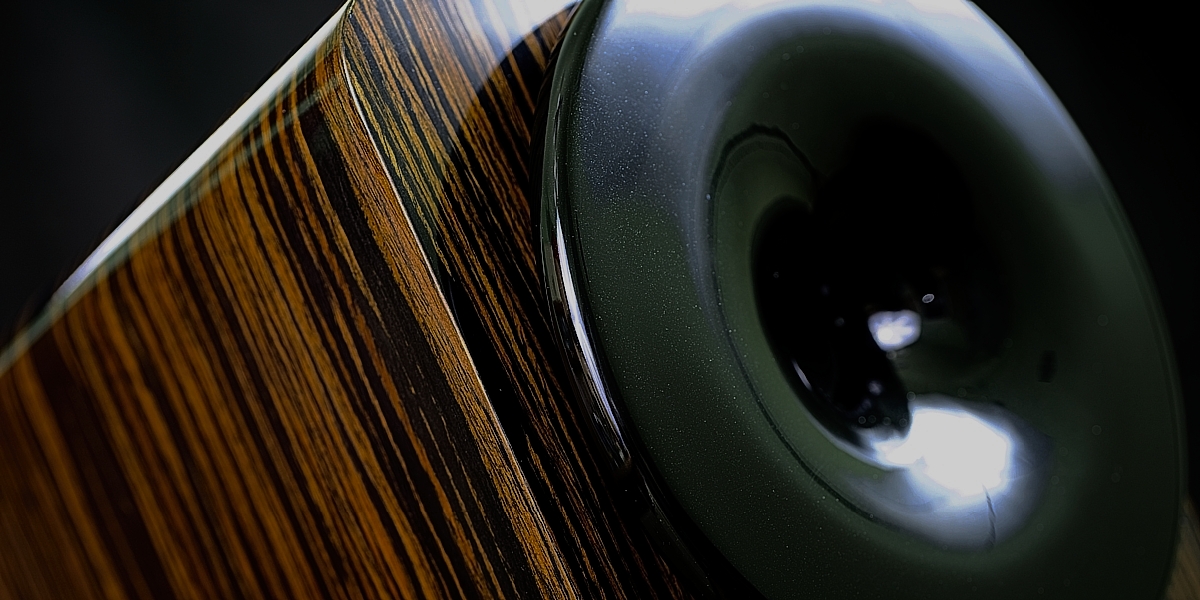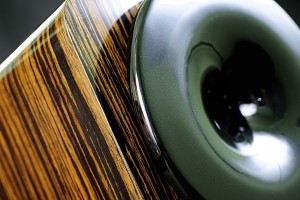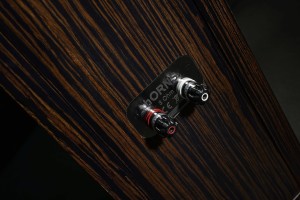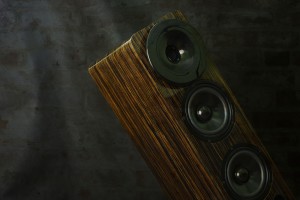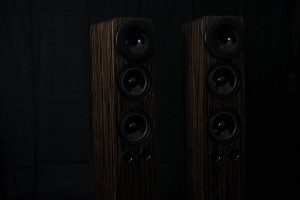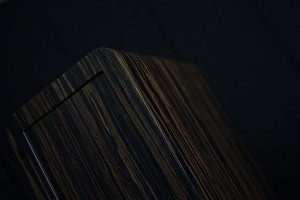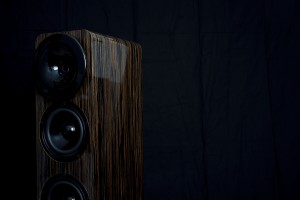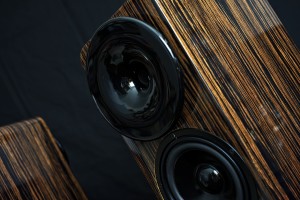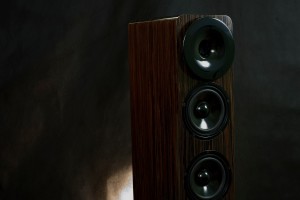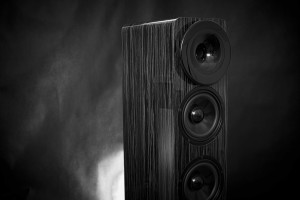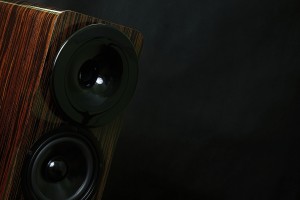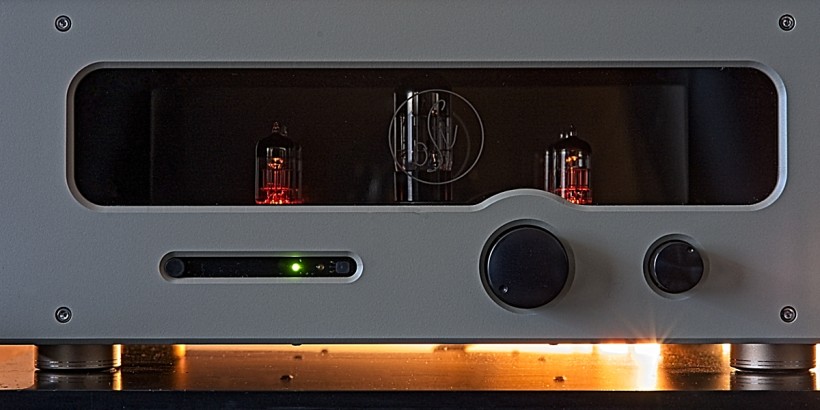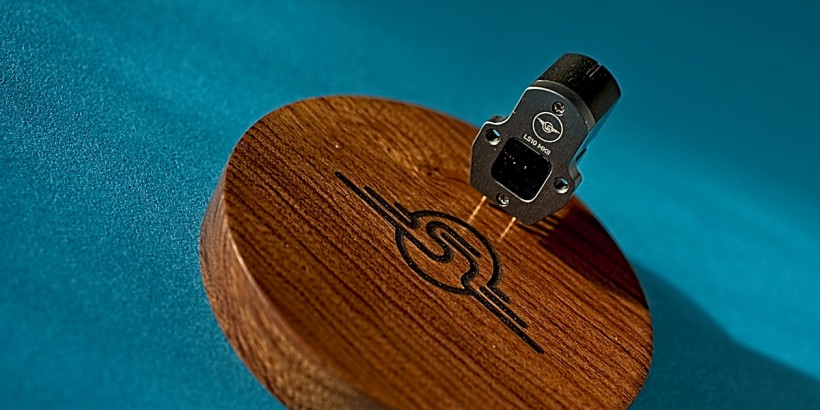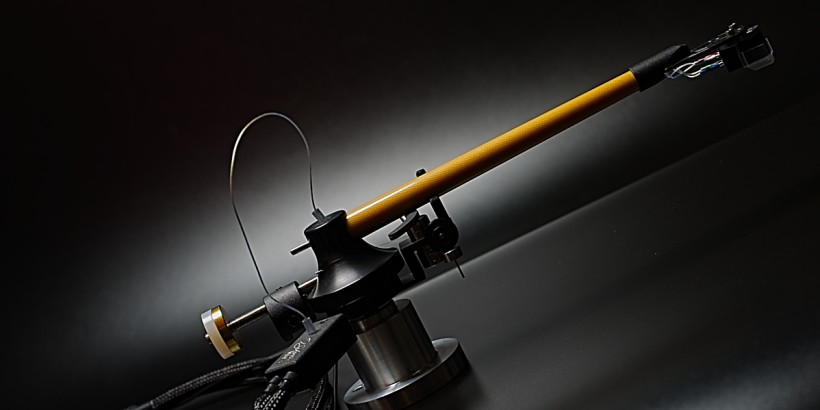The Lublin-based hORNS is one of those Polish audio brands that operate without making a big noise around them, even though they have been quite successful, not only on our market, but also abroad. This time I received the hORNS Aria II loudspeakers for a test, which caught my attention during the last Audio Video Show in Warsaw.
Introduction
You may remember a review a bit extravagant in form and great-sounding Mummy (see HERE) model. It was actually my first review of this brand’s product. As you might have guessed, it only encouraged me to get to know other products from hORNS’ lineup. In fact, we’ve known each other with Łukasz Lewandowski, the head of hORNS, for quite a few years. His loudspeakers are usually used in, as I call it, the Polish room at the Munich High End Show, but you might have seen them also during the Audio Video Show presentations, in recent years often in more than one room. The hORNS company is a member of the Polish Audio Claster, an organization associating Polish manufacturers, who combined their efforts to promote and exhibit together. In case you don’t know it already, one of Cluster’s goals is to offer complete high performance and importantly (!) deliberately set up, well-proven audio systems that combine products of the member companies. hORNS speakers are usually used in one of the Cluster’s systems (not in all of them, because there is more then one member offering loudspeakers). Additionally, since this brand comes from Lublin, same as the J.Sikora (also a member of the Cluster and the maker of my outstanding turntable), more and more often you can see these two brands combining their efforts and preparing fantastic presentations in the aforementioned room in Munich, but also in Warsaw for the AVS, and also for some other Shows around Europe. There is yet another element of this puzzle – I have been a fan of horn loudspeakers for many years. First of all, I simply like the kind of performance such speakers usually deliver. Secondly, most of such designs are perfect partners for my favorite tube SETs. Since we have a manufacturer of such loudspeakers here in Poland, my interest in their products seems absolutely natural. 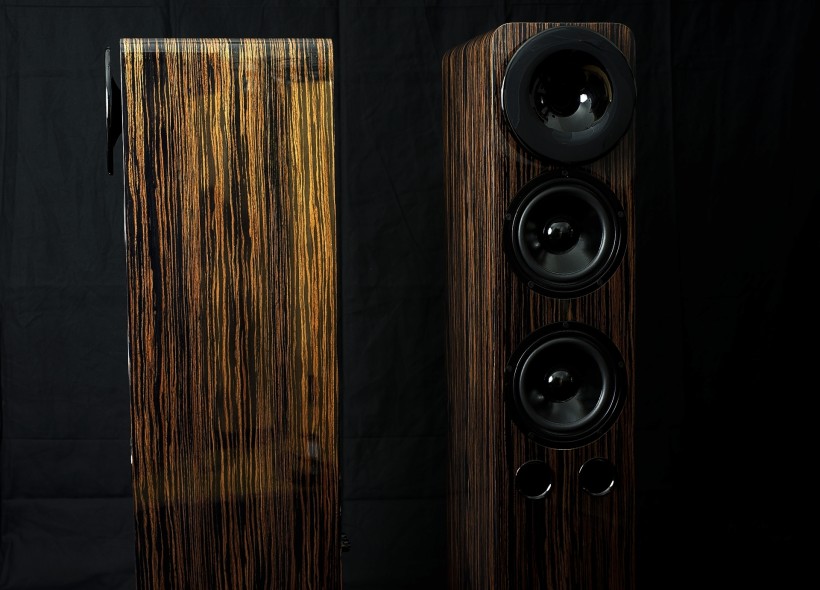 This review is a direct consequence of the Audio Video Show in Warsaw. This year I visited National PGE on the first day. There, I had an opportunity to listen to the system with the turntable, new tonearm, phonostage and monoblocks of Mr. Janusz Sikora (I already had a chance to use this new arm on my deck – it is brilliant – and I hope it will come for a review real soon). J.Sikora’s tube amplifiers were driving… hORNS Symphony speakers. It was an amazingly sounding system! Of course, the qualities of all Mr. Sikora’s components contributed significantly to this fantastic performance, but all this would have been useless unless the speakers that ultimately converted electric signal to audible sound were of a lesser quality. All this, plus a unique manufacturer’s commitment to preparing the best possible (not only sonically but also visually) presentation for the Show, that was obvious for anyone who saw how perfectly the speakers’ finish matched the color of the walls, urged me to immediately ask Mr. Łukasz for a review pair being delivered to my place. I’ll keep this true story about the color match to myself for now hoping that I can use it if/when I get Symphony for a review. We agreed with Mr. Łukasz that the review would take place, but for various reasons, only some time (few months) after the Show.
This review is a direct consequence of the Audio Video Show in Warsaw. This year I visited National PGE on the first day. There, I had an opportunity to listen to the system with the turntable, new tonearm, phonostage and monoblocks of Mr. Janusz Sikora (I already had a chance to use this new arm on my deck – it is brilliant – and I hope it will come for a review real soon). J.Sikora’s tube amplifiers were driving… hORNS Symphony speakers. It was an amazingly sounding system! Of course, the qualities of all Mr. Sikora’s components contributed significantly to this fantastic performance, but all this would have been useless unless the speakers that ultimately converted electric signal to audible sound were of a lesser quality. All this, plus a unique manufacturer’s commitment to preparing the best possible (not only sonically but also visually) presentation for the Show, that was obvious for anyone who saw how perfectly the speakers’ finish matched the color of the walls, urged me to immediately ask Mr. Łukasz for a review pair being delivered to my place. I’ll keep this true story about the color match to myself for now hoping that I can use it if/when I get Symphony for a review. We agreed with Mr. Łukasz that the review would take place, but for various reasons, only some time (few months) after the Show.
The next day I was in Radisson Sobieski Hotel. In one of the rooms I met Karol Staworko, the designer of the best USB and LAN cables I know. You might know the brand already – the StavEssence Audio (see HERE) and if you don’t, you should give it a chance (if you need audiophile grade LAN and/or USB cables). He prepared a presentation with two other brands, theIdeon Audio with their DAC and USB re-clockers and the LDMS music server from the Lucas Audio Lab. The latter, although based in the UK, is run by Lucas Domansky, or just Łukasz Domański, our guy in the UK, so we might as well say, it’s a (almost) Polish company. In fact, I went into this room because audio servers of the latter were strongly recommended to me by another of our „UK guys”, Greg Drygala. The setup in this room consisted of the products of the above mentioned brands but it also featured … hORNS speakers. It was the new Aria II model. I liked this presentation a lot, hence I requested most of these components for reviews and I have already received both, Ideon Audio and Lucas Audio Lab products, so stay tuned. 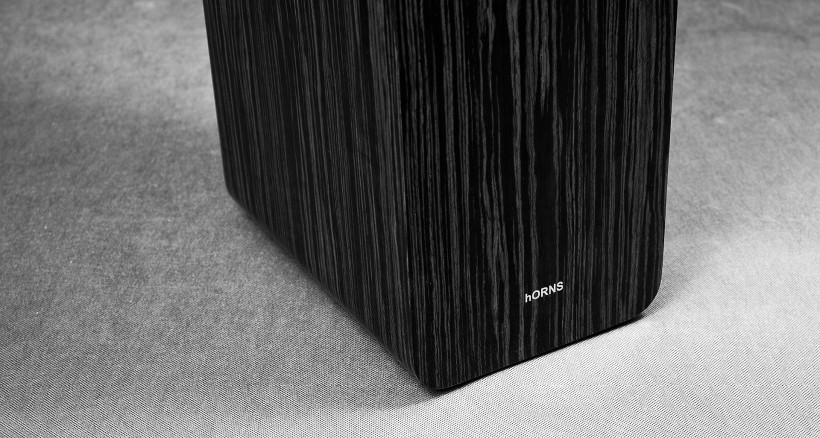 The first one to arrive to my place though, were the Aria II. Guys from hORNS brought them directly from the Show to my place, after I expressed my enthusiastic opinion about them. Unlike the quite unconventional (I refer to their form/shape) Mummies, the Aria II are more of a classic design (with just a small twist). Their cabinet is rectangular, though it features beautifully rounded edges both at the top and at the bottom of the speaker. These are medium sized floor-standing loudspeakers, measuring 109 cm, with a fairly narrow front (21cm). The cabinets are vented with a dual bass-reflex ports facing forward. The ports are placed quite high above the floor, and all drivers sit above them. There are two 7” woofers with paper cones, and above them there is a 1” tweeter operating inside, if you remember the company’s name you know what’s coming, a small horn that was developed in-house. The diameter of the latter is so small that it does not protrude beyond the width of the front baffle. In other words, it is a “normal”, not too big, great-looking speaker, that should not create any problems with your spouse or other family members because of its size, unconventional shape or appearance. It should be a safe choice especially considering the high quality of make and finish. One could say that the form might be a kind of a compromise in this case, although my listening session during the AVS did not confirm any in terms of sound quality. In fact I liked the sound a lot – the presentation was fast, dynamic, clean and coherent, plus, which is very important to me, there was no obvious boom from bass-reflex ports, that I simply can not stand. During my stay in this room, as part of the demo, Lucas played a track with some drummer’s astonishing performance, and although the room was rather small, the loudspeakers were not too big either, the presentation was impressive. Sure, I realize that one can always tweak a system for a show to make a huge impression on listeners. but I doubted that was the case. To find out whether I was right I wanted to listen to Aria II in my own room. Keep reading to learn about my findings after spending a few weeks with them.
The first one to arrive to my place though, were the Aria II. Guys from hORNS brought them directly from the Show to my place, after I expressed my enthusiastic opinion about them. Unlike the quite unconventional (I refer to their form/shape) Mummies, the Aria II are more of a classic design (with just a small twist). Their cabinet is rectangular, though it features beautifully rounded edges both at the top and at the bottom of the speaker. These are medium sized floor-standing loudspeakers, measuring 109 cm, with a fairly narrow front (21cm). The cabinets are vented with a dual bass-reflex ports facing forward. The ports are placed quite high above the floor, and all drivers sit above them. There are two 7” woofers with paper cones, and above them there is a 1” tweeter operating inside, if you remember the company’s name you know what’s coming, a small horn that was developed in-house. The diameter of the latter is so small that it does not protrude beyond the width of the front baffle. In other words, it is a “normal”, not too big, great-looking speaker, that should not create any problems with your spouse or other family members because of its size, unconventional shape or appearance. It should be a safe choice especially considering the high quality of make and finish. One could say that the form might be a kind of a compromise in this case, although my listening session during the AVS did not confirm any in terms of sound quality. In fact I liked the sound a lot – the presentation was fast, dynamic, clean and coherent, plus, which is very important to me, there was no obvious boom from bass-reflex ports, that I simply can not stand. During my stay in this room, as part of the demo, Lucas played a track with some drummer’s astonishing performance, and although the room was rather small, the loudspeakers were not too big either, the presentation was impressive. Sure, I realize that one can always tweak a system for a show to make a huge impression on listeners. but I doubted that was the case. To find out whether I was right I wanted to listen to Aria II in my own room. Keep reading to learn about my findings after spending a few weeks with them.
Design
The Aria II is another medium sized floor-stander from Aria line. It is the biggest and the most versatile line of this Polish manufacturer. Currently, it consists of four floor-standing models, a central speaker and a subwoofer. This clearly shows that Aria can be used either for stereo or multi-channel (including home cinema) setups. For this test I received a model marked with the Roman number II. This is a 2-way design with vented cabinet – with two small front-firing bass-reflex ports – measuring 210x1090x320 mm (40l internal volume). Despite relatively small size, the weight of this model is quite impressive – one speaker weighs around 35kg. It came as surprise to me (when I had to move them around) so I asked where this weight came from. The designer explained that they used a 28 mm thick MDF (usually a 22mm one is used) plus they added additional bracing to ensure adequate rigidity of the entire design. As in other models of this brand, inside cabinets are damped against vibration using bituminous mats combined with felt. 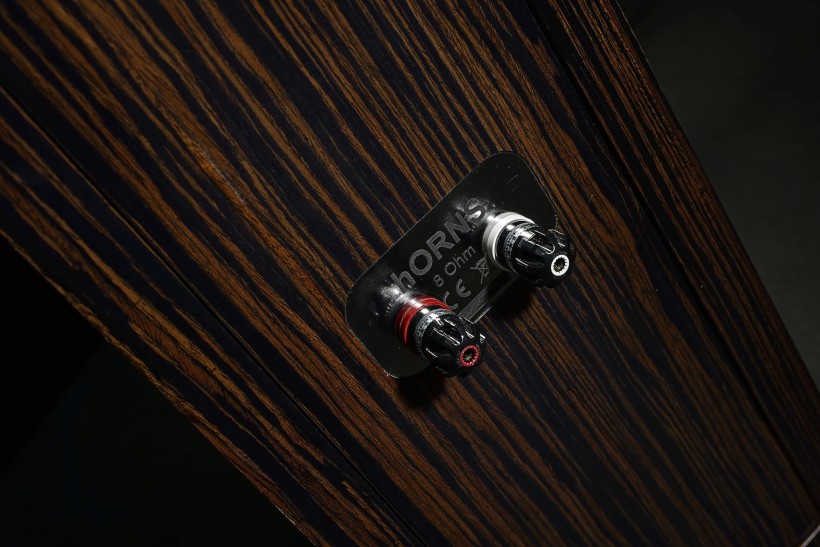 Each Aria II speaker features three drivers. The treble is reproduced by a 1-inch compression driver cut off with a first-order filter. It operates inside a horn developed in-house by the manufacturer. The mid- and bass ranges are reproduced using two 7-inch woofers cut off by a second-order filter. High-quality components plus an impedance matching circuit are used in the crossover. The combination of the latter with a relatively high efficiency of 88 dB makes Aria II quite an easy load to drive. The internal wiring is made of solid core cables for the tweeter and a braided one for the woofers. On the rear panel one will find high-end single WBT terminals. The speakers feature rubber feet, not spikes, so that the owners of soft floors do not have to worry about damaging them. The manufacturer provides users with individual, round magnetic grills for woofers that can be easily taken off for listening sessions.
Each Aria II speaker features three drivers. The treble is reproduced by a 1-inch compression driver cut off with a first-order filter. It operates inside a horn developed in-house by the manufacturer. The mid- and bass ranges are reproduced using two 7-inch woofers cut off by a second-order filter. High-quality components plus an impedance matching circuit are used in the crossover. The combination of the latter with a relatively high efficiency of 88 dB makes Aria II quite an easy load to drive. The internal wiring is made of solid core cables for the tweeter and a braided one for the woofers. On the rear panel one will find high-end single WBT terminals. The speakers feature rubber feet, not spikes, so that the owners of soft floors do not have to worry about damaging them. The manufacturer provides users with individual, round magnetic grills for woofers that can be easily taken off for listening sessions.
Sound
I know many people who approach horn loudspeakers with trepidation. They assume that using horns automatically means a reproduction of a colored sound. Presently, I do not own this type of speakers, but I did in the past. I always liked to prove to such guys that, as with every solution used in audio, it is the designer’s knowledge and experience that actually matters and it is definitely much more important factor contributing to the performance than the used solution itself. In the past, while having first Polish horns, and then Bastanis Matterhorns, I used to seat various people in front of them and play some music (or let them play whatever they wanted). I can proudly say that most of them after such a session changed their opinion to at least some extend acknowledging that horn speakers can deliver a really good performance. This allows me to boldly claim that horn loudspeakers can perform remarkably well (and it’s not only my opinion), and that in some respects they can even outperform other types of speakers (which in turn have their advantages in other aspects of the sound). The Aria II turned out to be another perfect example of a very good horn-based performer.  Before I get to backing my opinion, let me point put one more significant parameter of these speakers. Their nominal sensitivity at 88 dB is decent, but not exceptionally amplifier-friendly. On paper, these are not speakers particularly well-suited for a low output SET. During this test I listened to them primarily with two integrated amplifiers, both delivering fair output – my Class A solid-state GrandiNote Shinai (37W) and the tube SET – Ayon Crossfire III (30W). From the very beginning it seemed to me that these are optimal (or minimal) outputs for these speakers. However, I could not help myself and had to try them with my modified ArtAudio Symphony II, i.e. 300B SET (8W) and … let me leave this part for later, for a dessert, if you will.
Before I get to backing my opinion, let me point put one more significant parameter of these speakers. Their nominal sensitivity at 88 dB is decent, but not exceptionally amplifier-friendly. On paper, these are not speakers particularly well-suited for a low output SET. During this test I listened to them primarily with two integrated amplifiers, both delivering fair output – my Class A solid-state GrandiNote Shinai (37W) and the tube SET – Ayon Crossfire III (30W). From the very beginning it seemed to me that these are optimal (or minimal) outputs for these speakers. However, I could not help myself and had to try them with my modified ArtAudio Symphony II, i.e. 300B SET (8W) and … let me leave this part for later, for a dessert, if you will.
I have already mentioned it before, but I have to repeat it – what surprised me the most about these speakers, at least in the beginning, was bass performance. That presentation of how capable the system was during the AVS was already a strong clue, but we all know that the show systems can be tweaked to some extend to make them sound more impressive. In many cases, it is the bass performance that is boosted one way or another, simply because it is the easiest way to wow listeners, and on the other hand, many of them come looking exactly for that. In this particular system, I did not observe any obvious signs of adding extra juice to lower range. Those, who know me, know that I love big woofers – the bigger the better is what I used to say. My Ubiq Model One features a 12” bass woofer, the previous Bastanis Matterhorns used even 15 inches one. On the other hand, for over a year know I have also been using the GrandiNote MACH4. This is, in many respects, including performance, a unique design. They feature barely 5-inch wide-band drivers, and yet everyone, who listened to them in my placed asked the same question: where does this BASS come from? Long story short – I had to stop insisting that only speakers with at least 10” woofers can offer very good bass range performance. 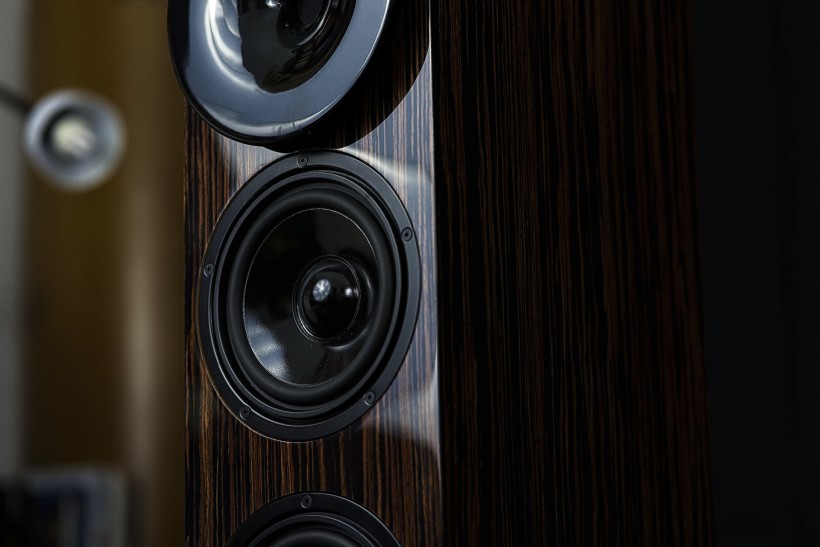 The Aria II, a 2-way design, features two 7-inch woofers and a tweeter. Of course woofers are supported by two bass-reflex ports, but these fire forward, so the interaction with a room is smaller than when port is placed on the rear of a speaker. And yet, although it was a bit amplifier-depended, it was the bass (particularly with Shinai) and the treble (especially with Ayon) that made the biggest first impression on me. And, which is extremely important (at least for me), the former was achieved without this ugly „boomy” effect that seems to be almost an intrinsic feature of the b-r designs, and the latter did not display any signs of aggressiveness or harshness. The former feature often repels me from relatively inexpensive b-r vented speakers, the latter is often described by their opponents as a common flaw of horn speakers.
The Aria II, a 2-way design, features two 7-inch woofers and a tweeter. Of course woofers are supported by two bass-reflex ports, but these fire forward, so the interaction with a room is smaller than when port is placed on the rear of a speaker. And yet, although it was a bit amplifier-depended, it was the bass (particularly with Shinai) and the treble (especially with Ayon) that made the biggest first impression on me. And, which is extremely important (at least for me), the former was achieved without this ugly „boomy” effect that seems to be almost an intrinsic feature of the b-r designs, and the latter did not display any signs of aggressiveness or harshness. The former feature often repels me from relatively inexpensive b-r vented speakers, the latter is often described by their opponents as a common flaw of horn speakers.
One of the first albums I listened to with the Aria II was Ray Brown’s “Soular Energy.” This is a perfectly recorded (I’m talking about vinyl release) double bass played by one of the biggest masters of this instrument, supported the fantastic Gene Harris at piano, and Gerryck King on drums. Unlike many double bass recordings, in this one the sound is not boomy or dull. It’s clean, fast, springy, as long as the system is able to play it like that. The Aria II did not have a problem with that. There was a good definition, differentiation, clearly marked, fast leading edge, but also an equally reliably presented sustain, decay and reverberations. Every element of the performance was there, in its right place, presented in a way that allowed me to focus on Ray Brown’s mastery instead of on assessing the sound of the speakers.  From the very beginning, it was also clear that hORNS have one of qualities shared by many horn loudspeakers – the foreground seemed to be extremely close and tangible, which translated into an impression of extremely direct or intimate contact with music and musicians. This was particularly obvious when I played some live recordings, such as the album of Jeff Goldblum, that most of you surely know as a great actor, released last year by Decca (!), or one of the Patricia Barber’s concerts. The Aria II created this intimate effect not so much by pushing the foreground in front of the line connecting loudspeakers, but rather by rendering large, but realistically large, rather than enlarged, tangible phantom images and densely filling the space between them and in front of them with the sound. The speakers may not be able to completely „disappear” from the room as some other, particularly stand-mounted ones do, but as for medium-sized floor-standers they did a very good job in this respect. All of these elements combined together created the impression of the exceptional closeness/intimacy with the performers. Obviously, I’m not talking about a level of intensity comparable to the one that actual participation in a live event can provide, but the Aria II in this respect did a better job then many, also more expensive competitors.
From the very beginning, it was also clear that hORNS have one of qualities shared by many horn loudspeakers – the foreground seemed to be extremely close and tangible, which translated into an impression of extremely direct or intimate contact with music and musicians. This was particularly obvious when I played some live recordings, such as the album of Jeff Goldblum, that most of you surely know as a great actor, released last year by Decca (!), or one of the Patricia Barber’s concerts. The Aria II created this intimate effect not so much by pushing the foreground in front of the line connecting loudspeakers, but rather by rendering large, but realistically large, rather than enlarged, tangible phantom images and densely filling the space between them and in front of them with the sound. The speakers may not be able to completely „disappear” from the room as some other, particularly stand-mounted ones do, but as for medium-sized floor-standers they did a very good job in this respect. All of these elements combined together created the impression of the exceptional closeness/intimacy with the performers. Obviously, I’m not talking about a level of intensity comparable to the one that actual participation in a live event can provide, but the Aria II in this respect did a better job then many, also more expensive competitors.
In my system / room, the Aria II while presenting such a clear, articulate foreground, did not forget about the the events that happened deeper into the soundstage. They surprisingly well presented deeper layers of the music, rich with information ans subtleties. Having said that, I also have to point out, that they do not belong to the speakers that created (I would like to emphasize that once again – in my room / system, as it really matters) some exceptional depth or the width of the stage. The presentation was surely three-dimensional and realistic (I am talking mostly about live recordings again) and orderly, at least when the interior of a small club was presented. Such recordings seemed to be the specialty of the Aria II, as they allowed me to (almost) participate in the event. On the other hand, when it came to outstanding recordings in this respect, such as my favorite version of “Carmen” with Leontyne Price, or “Live in Noirlac” by Michel Godard, where huge spaces were beautifully caught on tape, and some events and reverbs take place far away behind the foreground, the depth of the stage was good, although not the best I’d heard in my room. Some other speakers, including my Ubiq Model One and MACH4, were able to better reflect the incredible depth of the soundstage in these remarkable recordings. 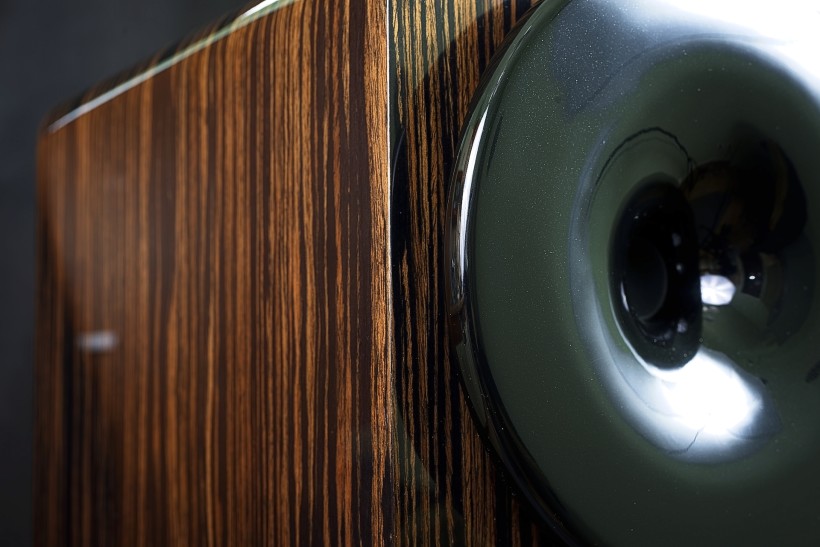 It was with Aria II that I first auditioned boxes number one and two with Kate Bush newly re-mastered albums. I plan to write a little piece about these releases (if there is time for that), but I can’t resist a temptation to recommend them to all Kate Bush fans. And if you are not one of them yet, purchase these boxes and thank me later :). Getting back to the speakers under review – I’ve already mentioned, how impressive the both band’s extremes were. I focused on them not because I did not appreciate the midrange performance, but simply because such a high quality bass and treble presentation in this price range was rather unexpected. As soon as the wonderful Kate Bush began to sing for me, it became clear that hORNS designer had not forgotten about the most important, absolutely key frequency range when developing the new Aria II. The midrange presentation is simply so good, so saturated, lively, colorful, smooth and natural that … one does not really pay attention to it. Does it mean that there was nothing special about it? Absolutely not! Often when I review various audio components there is something in their performance that does not quite sit with me. Sometimes it is difficult to put a finger on what exactly it is, but what I’m sure about in such cases is that something somewhere does not sound as natural as it should. When that happens instead of concentrating on the music, I spend time wondering what’s wrong. I am happy to report that music was the only thing that mattered with the Aria II. Sure, Kate Bush did not sound quite as amazingly lively as during the Audio Video Show when played by Piotr Metz using a very expensive system in the Soundclub’s room. Back then the resolution, clarity and finesse of the performance were even better, but the (Marten) loudspeakers alone cost 10 times (maybe more?) more then the reviewed hORNS. During this test it was important for me, that these relatively inexpensive speakers were easily able to convey both the remarkable quality of new re-masters and the magic of the unique Kate Bush voice. They simply did a great job.
It was with Aria II that I first auditioned boxes number one and two with Kate Bush newly re-mastered albums. I plan to write a little piece about these releases (if there is time for that), but I can’t resist a temptation to recommend them to all Kate Bush fans. And if you are not one of them yet, purchase these boxes and thank me later :). Getting back to the speakers under review – I’ve already mentioned, how impressive the both band’s extremes were. I focused on them not because I did not appreciate the midrange performance, but simply because such a high quality bass and treble presentation in this price range was rather unexpected. As soon as the wonderful Kate Bush began to sing for me, it became clear that hORNS designer had not forgotten about the most important, absolutely key frequency range when developing the new Aria II. The midrange presentation is simply so good, so saturated, lively, colorful, smooth and natural that … one does not really pay attention to it. Does it mean that there was nothing special about it? Absolutely not! Often when I review various audio components there is something in their performance that does not quite sit with me. Sometimes it is difficult to put a finger on what exactly it is, but what I’m sure about in such cases is that something somewhere does not sound as natural as it should. When that happens instead of concentrating on the music, I spend time wondering what’s wrong. I am happy to report that music was the only thing that mattered with the Aria II. Sure, Kate Bush did not sound quite as amazingly lively as during the Audio Video Show when played by Piotr Metz using a very expensive system in the Soundclub’s room. Back then the resolution, clarity and finesse of the performance were even better, but the (Marten) loudspeakers alone cost 10 times (maybe more?) more then the reviewed hORNS. During this test it was important for me, that these relatively inexpensive speakers were easily able to convey both the remarkable quality of new re-masters and the magic of the unique Kate Bush voice. They simply did a great job.
So when I heard her singing just for me, from this absolutely fantastic re-master (I’m still talking about the vinyl release), it immediately became clear that the midrange was very natural. How could I tell? Not only because there was nothing bothering me, distracting from enjoying this music, but also because I got goose bumps, and I had this broad smile on my face all the time. I even felt like singing along, but luckily for my relations with neighbors, I did not give in to this crazy idea. It does not change the fact that Aria II driven by Crossfire, with my J. Sikora turntable equipped with … well, the new, sensational Kevlar tonearm and my AirTight PC3 cartridge delivered performance that made me spent a better part of the night listening to all 7 albums (8 records!) in a row. I just couldn’t stop. Sure, the whole system was quite expensive (although still much cheaper then the aforementioned one during the Audio Video Show), sophisticated (it included also Siltech speaker, power and signal cables and GrandiNote phonostage), but it was the pair of the reviewed 3.000 EUR hORNS loudspeakers that actually reproduced the sound in such a unique, immersive, refined way. 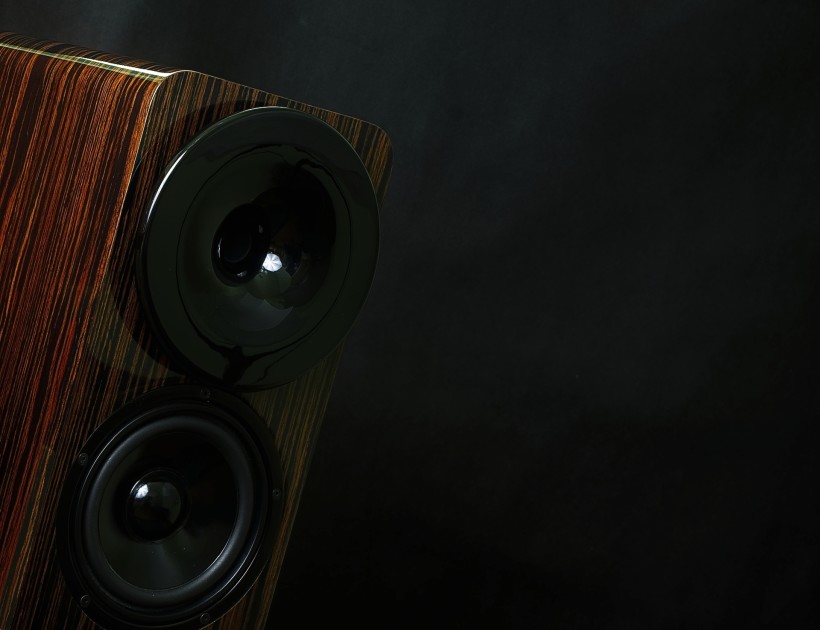 The vocal is not the only remarkable element on these new releases. Instruments and backing vocals accompanying the vocalist sounded excellent too. By excellent, I also understand very natural, smooth, saturated, yet clean and transparent, uncolored. I do not have Kate Bush’s first-press releases, only some newer ones, so I could compare the latest edition only with the latter and it was clear that the new re-masters sounded cleaner, were more expressive, with a better-arranged, focused sound, with some elements presented in a clearer, more distinct way, I mean the ones that on previous versions were buried under/behind the vocals. The Aria II perfectly used that element to their advantage beautifully conveying the ambiance and mood of this music, on the one hand focusing my attention on the vocal, on the other rendering a fuller, more vivid, more present image of the accompanying musicians and singers. Despite this typical for horn loudspeakers directness of the presentation and the strong, open, vibrant, yet not bright treble, the sound never got too bright or harsh. It was smooth, open and extremely enjoyable.
The vocal is not the only remarkable element on these new releases. Instruments and backing vocals accompanying the vocalist sounded excellent too. By excellent, I also understand very natural, smooth, saturated, yet clean and transparent, uncolored. I do not have Kate Bush’s first-press releases, only some newer ones, so I could compare the latest edition only with the latter and it was clear that the new re-masters sounded cleaner, were more expressive, with a better-arranged, focused sound, with some elements presented in a clearer, more distinct way, I mean the ones that on previous versions were buried under/behind the vocals. The Aria II perfectly used that element to their advantage beautifully conveying the ambiance and mood of this music, on the one hand focusing my attention on the vocal, on the other rendering a fuller, more vivid, more present image of the accompanying musicians and singers. Despite this typical for horn loudspeakers directness of the presentation and the strong, open, vibrant, yet not bright treble, the sound never got too bright or harsh. It was smooth, open and extremely enjoyable.
It’s time for a dessert. As I mentioned before, on paper it seemed that 8W output from the 300B SET would not be enough to drive the Aria II properly. I mean ensure enough power so that the speakers perform without distortion, compression or any other symptoms of a mis-match. It wasn’t either the first nor surely the last time that I found out that the parameters (specified by the manufacturers) are never enough to properly assess a given component (which applies particularly to loudspeakers) or to tell what it can or can’t be set up with. My (modified with output transformers from a higher model) ArtAudio Symphony II played even the already mentioned “Soular energy” splendidly, with beautiful, colorful, well-differentiated in terms of tone and dynamics double bass. The proportions between strings and wood were also correct. The bass was nicely extended and well controlled, rich, full, with long reverb, excellent timing. There was swing and feeling and everything one needs to truly enjoy such music and appreciate the mastery of the performers. The amplifier had a nice grip over Aria II speakers and drums performances were the best proof of that fact. In one of the tracks, there was an impressively conveyed, fast drums solo. It lacked no energy nor dynamics, and timing was also close to perfect. So as the actual setup proved, that an output of 2 x 8W may be enough to flawlessly drive the Aria II, although it will definitely depend on the class of the amplifier, and above all on the quality of its power and output transformers. 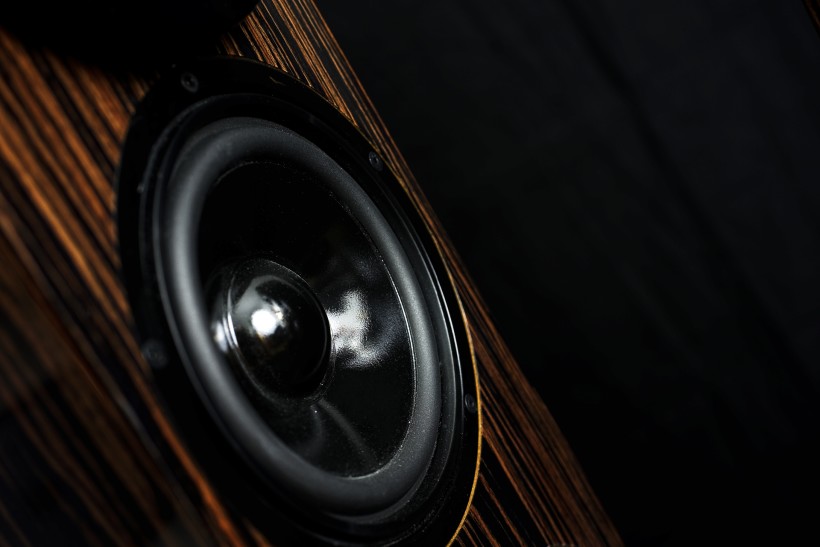
Summary
I have been regularly visiting various Audio Shows but not really in a hope of being wowed by presented systems, as they usually don’t sound that good in a show’s questionable acoustic environment. I do realize that many of them are actually capable of a much better performance. On the other hand, however, if something is able to catch my attention, it always confirms its class during a review. It is no different with the hORNS Aria II loudspeakers that wowed me during AVS and confirmed that impression during weeks I spent with them in my room. You may agree with me or not, but I think that hORNS’ products offer amazing value in terms of make&finish and above all performance, for their price. The tested model is by no means an exception. The Aria II offer several sonic qualities characteristic for horn speakers, such as directness of the presentation, they are very fast, they build large phantom images that are exceptionally present in a room, they are able to nicely recreate an ambiance and vibe of many high quality recordings. At the same time, this particular model also manages to avoid coloration of the sound that is often associated with horn speakers. I did not hear any nasal vocals, the double bass was large, but not enlarged, same as guitar, saxophone or violin, and the speed, focus and energy (without any bass-reflex boom) of the bass was truly impressive. And all this performance was delivered by relatively small, featuring only two 7” woofers, and a tweeter in a small horn, well-made and finished boxes. As if that wasn’t enough for a strong recommendation, they sounded equally great with the 8W SET amp, as with the 30 watt one and a 37 W Class A solid-state. The musical genre did not really matter – they were fully capable of playing anything I threw on them. Sure, they do not offer an ultimate performance as these are not the best speakers in the world, but the price / performance ration is, in my humble opinion, remarkable! The Aria II could easily compete with many even more expensive conventional designs. If you’re looking for speakers in this price range you should give them a chance.
UPDATE
I took me a longer then usually to write and publish this review. Between the AVS in Warsaw, when I received the reviewed pair, and now, the manufacturer already upgraded the Aria II to mk2 version. Obviously the goal was to further improve the already excellent performance which is also reflected in somewhat higher price. I am certain though, that if my review has encouraged you to try out the hORNS Aria II yourself, the mk2 version will do even better job in winning you over.
Technical specification (according to manufacturer):
- Format: 2-way
- Tweeter: compression driver 1 x 1”
- Woofer / mid-woofer: 2 x 7”
- Crossover: 12 dB
- Cabinet: bass-reflex, 40l
- Sensitivity: 88 dB
- Frequency range: 45-23000 Hz
- Impedance: 8Ω
- Speaker posts: single WBT
- Dimensions: 210x1090x320 [mm]
- Weight: 35 kg / pc
Price (when reviewed):
- hORNS ARIA II mk2: 3750 EUR / pair
Manufacturer: hORNS
Associated equipment:
- Analogue front end: J.Sikora Basic MAX turntable, Schroeder CB tonearm , AirTight PC-3, phonostages: Grandinote Celio mk IV, ESE Lab Nibiru V 2.5
- Digital source: a passive, dedicated PC with WIN10, Roon, Fidelizer Pro 7.3, JCat USB Femto card with Bakoon battery power supply, Hdplex linear power supply for PC, JCAT USB Isolator
- D/A Converter: LampizatOr Golden Atlantic
- CD/SACD Player: Ayon Audio CD 35 HF
- Power amplifier: GrandiNote Shinai, Ayon Audio Crossfire III, ArtAudio Symphony II (modified)
- Preamplifier: Audia Flight FLS1
- Loudspeakers: Ubiq Audio Model ONE Duelund Edition. GrandiNote MACH4
- Interconnects: Hijiri Million (RCA), Less Loss Anchorwave (RCA), KBL Sound Zodiac XLR, TelluriumQ Silver Diamond USB
- Speaker cables: LessLoss Anchorwave
- Power cables: LessLoss DFPC Signature, Gigawatt LC-3
- Power: Gigawatt PF-2 MK2 and ISOL-8 Substation Integra; a dedicated power line with Gigawatt LC-Y in-wall cable; Gigawatt G-044 Schuko and Furutech FT-SWS-D (R)
- Racks: Base VI, Rogoz Audio 3RP3/BBS
- Anti-vibration accessories: ROGOZ-AUDIO SMO40 and CPPB16 platforms and ROGOZ AUDIO BW40MKII feet, Franc Accessories Ceramic Disc Slim Feet and Wood Block Platform


